Rainbow Springs State Park: The Complete Guide
Florida's Rainbow Springs State Park is a slice of heaven on Earth.
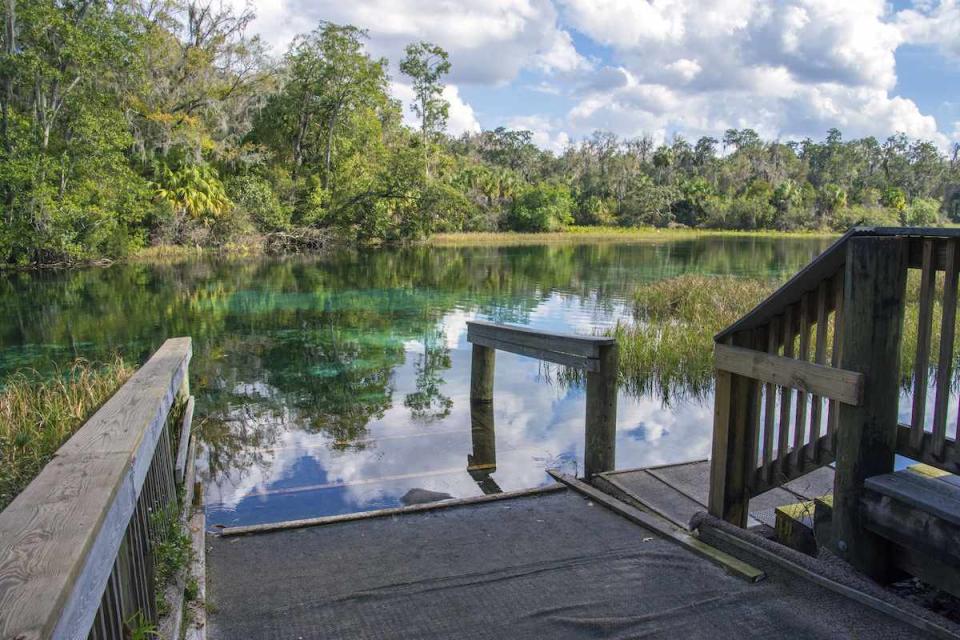
CampPhoto/Getty
Even though Florida's Rainbow Springs State Park is located just an hour and a half northwest of Orlando, it feels like an entirely different planet. While the city is alive with theme parks, tourist attractions, and boisterous nightlife, the park is a quiet sanctuary for those looking to connect with nature. The tranquil setting is a hidden gem that falls off the radar of most travelers, but it has a lot to offer to those willing to seek it out.
The park has been a refuge for wildlife, unique fauna, and human visitors for millennia. Its crystal clear waters—fed by one of the largest natural springs in the country—remain at a constant 72 degrees all year long. This makes it a refreshing place to escape the Central Florida heat, just as Native Americans did for hundreds of years.
Surrounded by a lush forest, the 1,000-acre park is scenic and serene. Visitors can wander along nature trails, take a dip in the cool waters, paddle a canoe or kayak, and spot wildlife in and around the river. There is plenty to see and do in Rainbow Springs State Park, making it a fantastic destination for travelers looking to get away from the typical tourist traps that are found in the area.
Here's what you need to know before you go.
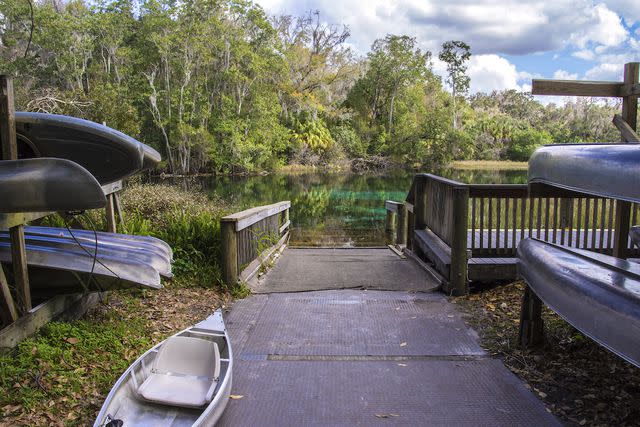
CampPhoto/Getty
Things to Do
Unsurprisingly, many of the popular activities inside Rainbow Springs State Park revolve around its pristine waters. But even if you don't feel like getting wet, there are still plenty of things to see and do there. Here are a few options for visitors.
Go Canoeing or Kayaking
In addition to being incredibly clear, the park's natural springs are also very smooth and calm. This makes it a fantastic place to go for a paddle, even for complete beginners. Visitors can glide along in a canoe or kayak, exploring this unique natural setting and often encountering wildlife along the way. And if you don't have a boat of your own, rentals are available near the headsprings launch area.
Float on an Inner Tube
For those who don't feel like paddling a canoe or kayak, tubing on the natural springs is an alternative option. The park offers onsite tube rentals, allowing visitors to have a more laid-back experience on the water. The Rainbow River's gentle current will push you along at a relaxed pace that is perfect for soaking up the scenery.
Swimming/Snorkeling
Because the natural springs maintain a constant 72-degree temperature all year round, it is a popular place to go swimming and snorkeling. Additionally, the waters are always crystal clear, which enhances the experience nicely. The depth of the water typically ranges between 10-18 feet, so swimmers are encouraged to wear life jackets or use pool noodles for their own safety. Inflatable rafters, tubes, and other equipment are not allowed.
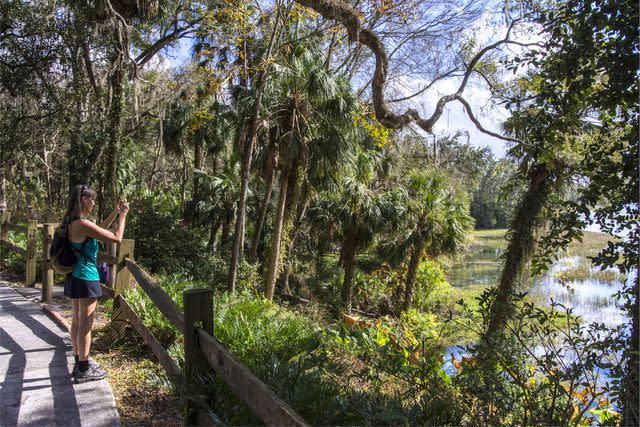
CampPhoto/Getty
Hike the Nature Trail
The park has a 2.5-mile-long nature trail that allows visitors to stretch their legs before or after taking a plunge in the river. The route is relatively smooth, paved, and well-shaded, offering great views of the Rainbow River, as well as three manmade waterfalls. An offshoot route even takes hikers past an old phosphate pit—a mineral that is found in abundance in the area and was once commercially mined there.
Spot Wildlife
Keen-eyed visitors to Rainbow Springs may spot some unique wildlife during their time in the park. Turtles, otters, and manatees can often be seen enjoying the refreshing waters and soaking up the sun. The park is also home to an array of bird species, including the great egret, green heron, ruby-throated hummingbirds, barn owls, and dozens more. There are even 40 species of butterflies that live in the region, bringing flashes of color to the lush setting.
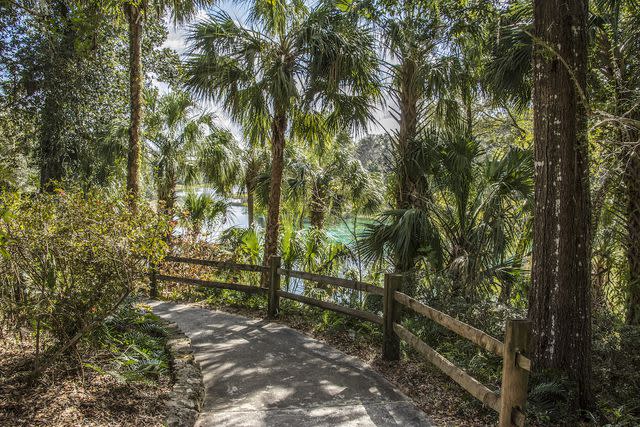
CampPhoto/Getty
Best Hikes and Trails
Rainbow Springs State Park only has one hiking trail, although it does offer a few short side routes for visitors to explore. The 2.5-mile-long loop starts at the Visitor Center and is an easy walk, with only a few rolling hills to traverse. The main path is paved as well, making it accessible to all visitors, including those in wheelchairs. Some of the side trails—including the one out to the phosphate pit—are unpaved, however, although they remain highly accessible.
While the route isn't long or strenuous, it is definitely enchanting. The path wanders through a garden where magnolia trees and azalea bushes grow and is often covered by a canopy of oak trees. Hikers will find several scenic locations that overlook the Rainbow River, and birders will love the opportunity to spot new species. The trail even passes by three waterfalls—a rarity in the relatively-flat state of Florida.
Even when stopping to take in the sights, most visitors can walk the entire trail in under an hour. The path is well-marked, easy to follow, and very quiet on weekdays. It can get somewhat crowded on weekends, however, so plan your visit accordingly.
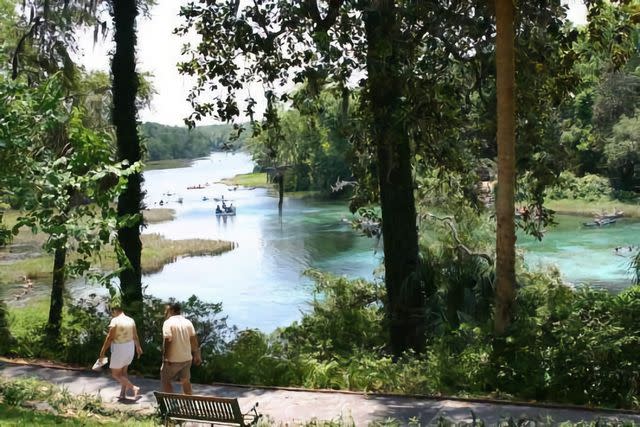
Ocala/Marion County, FL Tourism
Campgrounds
The Rainbow Springs State Park Campground is located outside the park itself, just a few miles from the main headspring and day-use area. It features 60 individual sites for both tent and RV camping, many of which offer scenic views of the river. Pets are welcomed at the campsites, although they should remain on a leash at all times and are prohibited from buildings and swimming areas.
Each campsite includes water and sewer hookups for RVs, along with electric, including 20, 30, and 50-amp shorepower. Onsite amenities include a store, restrooms, showers, and a laundromat. Canoes and kayaks can be rented there as well, and RVers can access a dump station on the premises.
For security reasons, the campground has a gate that remains closed at all times. Visitors with a campsite reservation can obtain the gate code by calling the campground office at 352-465-8550 between 10:00 am and 5:30 pm daily. The code changes periodically, so it may be necessary to obtain a new one during your stay.
The Rainbow Springs campground can get crowded on weekends and during the busy summer travel season. Those planning to stay there are encouraged to make a reservation well in advance of their visit. Reservations can be made online or by calling 800-326-3521 or TDD 888-433-0287. The cost of camping in the park is $30/night.
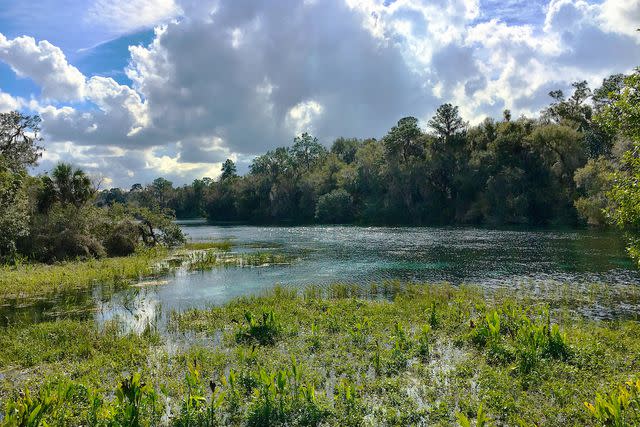
CampPhoto/Getty
Lodging
There are no hotels or lodges located inside Rainbow Springs State Park. Visitors who don't plan on camping will find an array of accommodations in the nearby town of Dunnellon and the city of Ocala. Both metropolitan areas have a variety of national hotel chains, B&Bs, and homestay rentals, with Ocala having a larger selection to choose from.
Visitors will find accommodation options to fit any budget, with most located within a short drive of the park. Some of the more unique and eclectic places to stay in the area include the Gator Den Motel, the Country Chalet Inn, and The Equestrian.
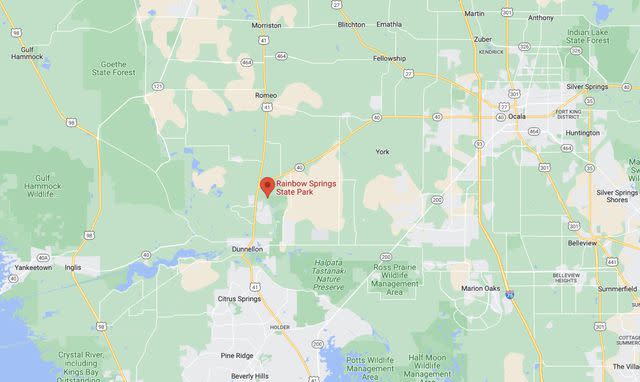
Google Maps
How to Get There
Rainbow Springs State Park is located just five miles outside of Dunnellon, off US Highway 41 N. along SW 81st Pl Rd. Signs mark the way, making it easy to find the main entrance.
Visitors arriving from Ocala will take FL-40 W to US Highway 41 S, turning onto SW 81st Pl Rd. The drive is about 22 miles in length and takes about a half hour to reach the park.
Gainesville is located roughly an hour's drive from Rainbow Springs. Travelers can take FL-121 south onto US Highway 41 before turning onto SW 81st Pl Rd.
Visitors making their way to the park from Orlando will travel on FL-408 W to Fl-50 W before turning onto the Florida Turnpike toll road. Stay on that highway to Ocala before exiting onto FL-40 W to 41S and eventually SW 81st Pl Rd. The trip covers nearly 100 miles and takes about two hours to complete.
Keep in mind, the park has three entrances. The main entrance is found off 81st Place Rd., but there is another entrance from the campground located on the east side of the river at 181815 SW 94th St. The third entrance is designated for visitors who want to go tubing on the river and is found at 10830 SW 180th Avenue. When navigating to the park, be sure you pick the right option.
The largest airports in the region are the Gainesville Regional Airport and Orland International. There are also several smaller county airports in the area, but renting a car and driving from one of the large access points is likely to be more economical.
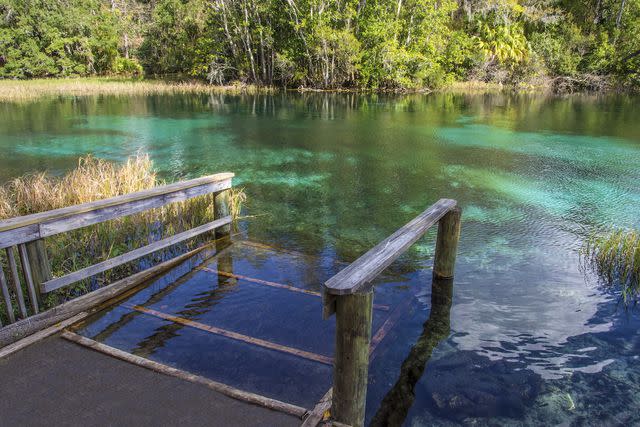
CampPhoto/Getty
Accessibility
Rainbow Springs gets high marks for offering a variety of accessible amenities. The park's facilities, including Visitor Center, restrooms, and parking lot, are wheelchair-accessible and ADA-compliant. The campground also has campsites—along with the camp store, showers, and laundromat— that offer wheelchair access. Additionally, all of the picnic facilities, concession stand, ornamental gardens, amphitheater, and interpretive exhibits are also accessible.
The 2.5-mile nature trail has a smooth paved surface that is well-maintained but was built before ADA guidelines were common. Because of this, the route can be uneven and difficult to maneuver by wheelchair in a few areas. The rolling hills also offer some steep inclines that can be hard to navigate as well. While it is not completely inaccessible to handicapped visitors, it isn't an easy path to follow either. The route does include a number of shaded benches that make good places to take a break when needed.
Some of the side trails are unpaved and can get muddy, which makes them less accessible by wheelchair or powered mobility device. Getting into the water can be a challenge, too, particularly in the designated swimming area, which has a ladder but lacks a pool lift. This limits the options for handicapped visitors looking to take a dip in natural springs.
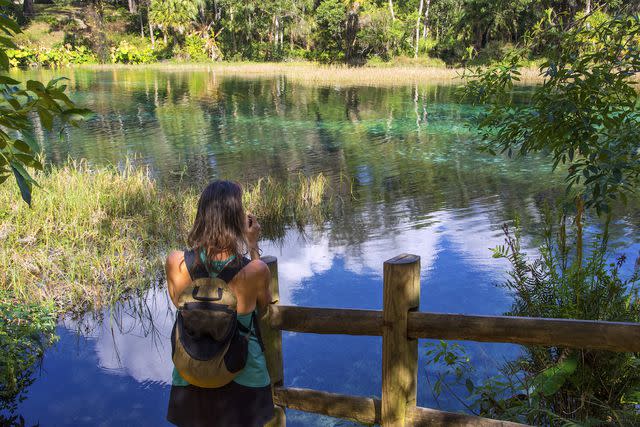
CampPhoto/Getty
Tips for Your Visit
Rainbow Springs State Park charges a nominal entry fee of $2. Tube, canoe, and kayak rentals cost extra.
Because the park is a wildlife preserve, fishing is not allowed in the headsprings day-use area. Registered campers can fish in the campground area, however, provided they have a Florida fishing license.
While there are limited drink and snack options at the park's Visitor Center, there are no restaurants on the premises. There is a concession stand near the headsprings entrance that serves sandwiches and snacks.
Nearby Dunnellon does have several restaurants to choose from, however, with Swampy's Bar & Grill and the Blue Gator among the local favorites.
There are uncovered picnic tables and grills available to visitors inside the park. Bring your own food and drinks to enjoy lunch in a wonderful outdoor setting.
The park can get crowded on weekends, particularly in the summer. But during the week, it tends to be relatively quiet. Mondays and Tuesdays can be an especially good time to visit.
Some archaeologists believe that humans have been swimming in the natural springs for more than 10,000 years. Keep that in mind as you take the plunge yourself.
Snorkeling is allowed in the buoyed swimming area only while at the headsprings. Visitors can also snorkel at the campgrounds or from a boat outside the headsprings. A dive flag is required in those areas.
The park has four pavilions available for special events, like family reunions or work retreats. Those locations include picnic tables, grills, electricity, and water. There is also an amphitheater in the campground.

